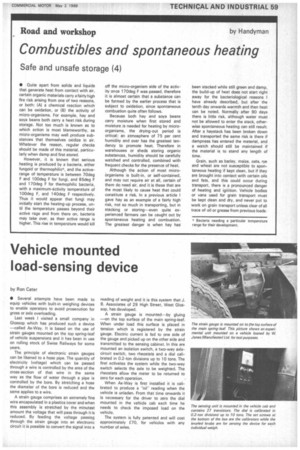Vehicle mounted load-sensing device
Page 61

If you've noticed an error in this article please click here to report it so we can fix it.
by Ron Cater • Several attempts have been made to equip vehicles with built-in weighing devices to enable operators to avoid prosecution for gross or axle overloading.
Last week I visited a small company in Glossop which has produced such a device —called Ax-Way. It is based on the use of strain gauges mounted on the top spring-leaf of vehicle suspensions and it has been in use on rolling stock of Swiss Railways for some years.
The principle of electronic strain gauges can be likened to a hose pipe. The quantity of electricity (voltage) which can be passed through a wire is controlled by the area of the cross-section of that wire in the same way as the flow of water through a pipe is controlled by the bore. By stretching a hose the diameter of the bore is reduced and the same applies to a wire.
A strain gauge comprises an extremely fine wire encapsulated in a plastics cover and when this assembly is stretched by the minutest amount the voltage that will pass through it is reduced. By feeding the voltage passing through the strain gauge into an electronic circuit it is possible to convert the signal into a reading of weight and it is this system that J. B. Associates of 29 High Street, West Glossop, has developed.
A strain gauge is mounted—by gluing —on the top surface of the main spring-leaf. When under load this surface is placed in tension which is registered by the strain gauge. Electric current is fed to one side of the gauge and picked up on the other side and transmitted to the sensing cabinet. In this are mounted an isolation switch, a two-way axlecircuit switch, two rheostats and a dial calibrated in 0.2-ton divisions up to 10 tons. The first activates the system while the two-way switch selects the axle to be weighted. The rheostats allow the meter to be returned to zero for each operation.
When Ax-Way is first installed it is calibrated to produce a "nil" reading when the vehicle is unladen. From that time onwards it is necessary for the driver to zero the dial mounted in the vehicle cab each time he needs to check the imposed load on the vehicle.
The system is fully patented and will cost approximately £70, for vehicles with any number of axles.




















































































































































































































